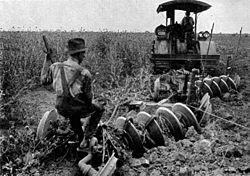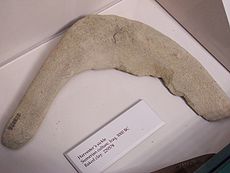History of agriculture
Agriculture has existed for more than 10,000 years.
Origins of agriculture
Ancient Origins
Agriculture is believed to have been developed at multiple times in multiple areas, the earliest of which seems to have been in Mesopotamia.[1] Pinpointing the absolute beginnings of agriculture is problematic because the transition away from purely hunter-gatherer societies, in some areas, began many thousands of years before the invention of writing. Nonetheless, Archaeobotanists/Paleoethnobotanists have traced the selection and cultivation of specific food plant characteristics, such as a semi-tough rachis and larger seeds, to just after the Younger Dryas (about 9,500 BC) in the early Holocene in the Levant region of the Fertile Crescent. Limited anthropological and archaeological evidence both indicate a grain-grinding culture farming along the Nile in the 10th millennium BC using the world's earliest known type of sickle blades. There is even earlier evidence for conscious cultivation and seasonal harvest: grains of rye with domestic traits have been recovered from Epi-Palaeolithic (10,000+ BC) contexts at Abu Hureyra in Syria, but this appears to be a localised phenomenon resulting from cultivation of stands of wild rye, rather than a definitive step towards domestication. In these contexts lie the origins of the eight so-called founder crops of agriculture: first emmer and einkorn wheat, then hulled barley, peas, lentils, bitter vetch, chick peas and flax. These eight crops occur more or less simultaneously on PPNB sites in this region, although the consensus is that wheat was the first to be sown and harvested on a significant scale.
By 7000 BC sowing and harvesting reached Mesopotamia and there, in the super fertile soil just north of the Persian Gulf, Sumerian ingenuity systematized it and scaled it up. By 6000 BC farming was entrenched on the banks of the Nile River, and by 5000 BC it spread to Greece on one side and to India on the other. About this time, agriculture was developed independently in China, with rice rather than wheat as the primary crop. Maize was first domesticated from teosinte in the Americas around 3000-2700 BC. Somewhat surprisingly, systematic farming, principally of emmer and einkorn, reached northwestern Europe not via the Levant-to-Southern Europe but from central Asia by ca. 4,500 BC (see, among others, Price, D. [ed.] 2000. Europe's First Farmers. Cambridge University Press; Harris, D. [ed.] 1996 The Origins and Spread of Agriculture in Eurasia. UCL Press).
The reasons for the earliest introduction of farming may have included climate change, but possibly there were also social reasons (e.g. accumulation of food surplus for competitive gift-giving). Most certainly there was a gradual transition from hunter-gatherer to agricultural economies after a lengthy period when some crops were deliberately planted and other foods were gathered from the wild. Although localised climate change is the favoured explanation for the origins of agriculture in the Levant, the fact that farming was 'invented' at least three times, possibly more, suggests that social reasons may have been instrumental.
Full dependency on domestic crops and animals did not occur until the Bronze Age, by which time wild resources contributed a nutritionally insignificant component to the diet. If the operative definition of agriculture includes large scale intensive cultivation of land, mono-cropping, organized irrigation, and use of a specialized labour force, the title "inventors of agriculture" would fall to the Sumerians, starting ca. 5,500 BC. Intensive farming allows a much greater density of population than can be supported by hunting and gathering and allows for the accumulation of excess product to keep for winter use or to sell for profit. The ability of farmers to feed large numbers of people whose activities have nothing to do with material production was the crucial factor in the rise of standing armies. The agriculturalism of the Sumerians allowed them to embark on an unprecedented territorial expansion, making them the first empire builders. Not long after, the Egyptians, powered by effective farming of the Nile valley, achieved a population density from which enough warriors could be drawn for a territorial expansion more than tripling the Sumerian empire in area [2].
Ancient agriculture
Raised interest in raised beds Experienced gardeners may recall a meteoric rise in publicity and popularity during the 1970s of raised-bed vegetable production. What many of us didn't know was that farmers of several South and Central American societies practiced "raised-field" agriculture up to 4,000 years ago. Raised fields are what their name implies: cropland built up with soil and vege-tative material to mitigate the negative effects of high water tables and periodic flooding. Scholars of raised-field agriculture generally concur that the Mayan people of the lowlands of southern Yucatan in Mexico, parts of Belize and Guatemela, developed the system, whose adoption by other agriculture-based societies then proceeded northward. By the first century, raised-field agriculture was the modus operandi of food production in Teotihuacan, near present-day Mexico City. By the 16th century, the elevated rectangular fields, called chinampas, supplied grains, vegetables, and fruits to a quarter million Aztecs in Teotihuacan.
The chinampas system was still used in Teotihuacan in the late 19th century. Functional examples of the system persist today in Xochimilco in Mexico City and southwest Tlaxcala State, Mexico. Similar systems flourished in present-day Peru, Bolivia, and Ecuador well before Columbus' arrival in the New World. Popular use of the system began to decline at the time of the Spanish Conquest, and rapidly disintegrated over the next 20 years. Factors that influenced the decline include salinization, population pressures, inequitable access to technologies which affect labor use, such as plows. In some areas the Spanish completely destroyed the systems, breaking up the waterways and plowing into the chinampas. Recent studies are reviving interest in the chinampas system as a way to sustain food production in specific ecological conditions with minimal imported inputs.
To construct the chinampas system, the Aztecs removed and piled up aquatic vegetation and muck to create horticultural platforms flanked by waterways and drainage canals (zanjas). By dredging one vertical meter of canal debris every one to four years, farmers in Tlaxcala who employ the system today can add an estimated 1,000 kg total N, 10 kg P, and 120 kg K per hectare to their cropland. Trees such as willow and alder, which often grows in symbiosis with a nitrogen-fixing actinomycete (Frankia sp.), are planted around the islands' perimeters. The trees provide shade, increase diversity and anchor the soil in the wet environment reducing erosion.
A typical field measures 150 by 20 meters. The system's environment also provides habitat for fish and waterfowl. Today, alfalfa (originally brought over by the Spanish) is often grown for two to five years in a 3-meter strip that runs lengthwise in a raised field. The alfalfa is usually followed by corn in rotation. Thus, every 15 to 20 years, an entire raised field benefits from the nitrogen fixed by an alfalfa stand (from 30 to 300 kg N per ha per year).
Upland ingenuity also survives Some 200 kilometers east of Mexico City, another innovative agricultural system developed among the Aztecs as early as 1,000 B.C. Operating at 2,200 meters above sea level, this system featured canals, terraces, and earthen water storage tanks. Certain aspects of the system remain functional today, moreso than the chinampas which were constructed on what is today an urban area, while the cajetes were originally built in what remains a rural area. These include the funneling of rain runoff to a network of relatively small water tanks (cajetes) situated at the base of hillside terraces on cropland. The cajetes serve as catchments and compost pits for soil and organic debris carried by runoff water. The runoff is directed from cropland via the tank network. Nutrient-laden soil and decomposed debris is returned to the fields while trapped water percolates to recharge the water table. In the meantime, the tanks protect the terraces from structural damage due to runoff. The system's design reflects the concerns of its architects about intense rainfall events, a scenario that harbors the most potential damage to the tank network. Yet the most vital facet of the tank system is neither engineering nor agronomic, but social. All farmers who manage land within a given catchment area must agree to participate as needed to clean out the cajetes and replace the soil on the terraces, and to ensure that runoff from large storms is channelled from the crop area.
Another characteristic of the cajete system is its accent on plant diversity through intercropping, crop rotation, fallowing, and the maintenance of border areas. Fallowing is a means to restore soil fertility and suppress weed species. The border areas provide space for high- value plants such as fruit, fuel, and fodder trees, and medicinal species (see figure 2).
The trees that grow along field borders stabilize terraces, recycle soil nutrients, and serve as windbreaks, but more research is needed on the effects of many other border species on crops.

